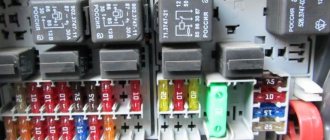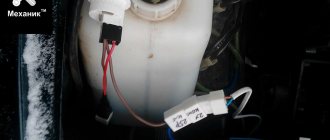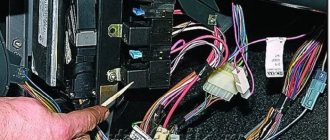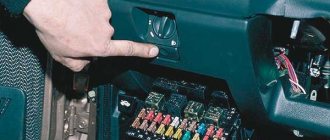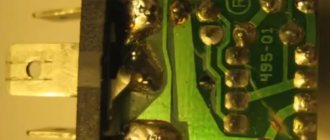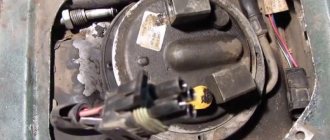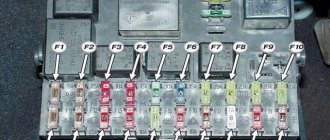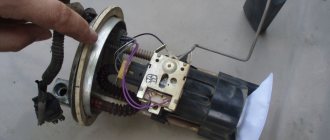A frequent and unpleasant question: why does the fuel pump fuse blow out? Many, faced with this problem, begin to chaotically look for new fuses and insert the first one they come across. In such a situation, it is not always possible to find exactly the right fuse.
Having installed a new element, the car drives a couple of tens of meters and stops again. At the same time, during these meters traveled, the car manages to shake and shake quite a bit.
The very name “fuse” indicates that this small element protects a more expensive device from failure. If the fuse blows, then the problem may lie in something more serious. Therefore, it is not advisable to insert another element instead of the desired one. The fuse consists of thin plates made of a certain material and they are of a fixed thickness.
A fusible element is soldered between the set of plates, which opens the circuit when overloaded. This entire structure is enclosed in a polymer mandrel.
FakeHeader
Comments 5
tell me what is the reason? same issue today, I looked through everything, the front light is on and that’s it
solved a problem? Today the same bullshit came up
no ((you need to remove the wiring and look for what the problem is... it disappears then lights up again ((
There are usually two reasons, either the pump is about to die, or the wiring is frayed in the area of the engine oil filler neck.
hmm... I found another diagram 1 - ignition module, controller; 2 – canister purge valve, vehicle speed sensor, oxygen (heating) sensor, air flow sensor; 3 – fuel pump relay, fuel pump, injectors. Additional relays: 4 – electric fan relay; 5 – electric fuel pump relay; 6 – main relay (ignition relay).
It turns out that the canister purge valve fuse is on, the vehicle speed sensor, the oxygen (heating) sensor, the air flow sensor... omg so what's the problem?
Where is the fuse for the fuel pump?
A frequent breakdown that is associated with the fuel system. is that the fuel pump fuse is blown. In this case, power is not supplied to the pump, and the fuel pump itself stops pumping gasoline into the main line. As a result, the car stalls, the pump does not buzz in the gas tank after turning the ignition key, and the engine does not start.
We also recommend reading the article on how to check the fuel pump relay with your own hands. From this article you will learn about where the fuel pump relay is located, as well as the available methods for checking it yourself.
What to do Lada Kalina won't start
Stylish crossover Kalina
A lot of time has passed since AvtoVAZ announced the launch of a new project called Lada Kalina. Grandiose advertising and hope for a bright future did their job: millions of Russians, out of patriotic feelings, decided to choose the domestic Kalina, discarding numerous projects by Renault, Volkswagen and other factories positioning reliability and quality. But the joy was short-lived.
Already in the first months, Kalina did not show her best side, showing a capricious disposition. And it turned out that Kalina’s owners began to spend more time in the garage doing repair work than on trips. Engineers know their shortcomings and try in every possible way to get rid of them in each next generation of cars, to come up with something to increase the reliability of the car.
But for some reason the results are still little noticeable. As before, the car cannot please you with its endurance and wear resistance. The most unpleasant problem is that Kalina does not start from time to time. To return the machine to working order, it is necessary to find out the causes of the malfunction, and there are many of them. So, let's try to figure out why the Lada won't start.
Why do fuel pump fuses blow?
A fuse is a small element whose task in the design of electrical circuits is to melt in the event of an overload. The device melts and the current-carrying circuit opens.
Using the example of a solution from the popular VAZ Priora model, we can superficially examine the design and operating principle of the fuse. The device is small, the outer casing is made of plexiglass.
There is a conductive element inside. Such an element is based on several plates, which are made of different materials. Between these plates there is a special low-melting material. Electricity passes through this material, which allows the fuse to be an integral part of the electrical power circuit of the fuel pump.
Fuses have a special marking in the form of the letter F. This designation indicates that the fuse element belongs to a circuit whose power is not large. To calculate the current that certain devices are designed for, you need to divide the power by 220. The result will be a figure in amperes.
If the fuse is blown, then such a malfunction is often caused by the following reasons:
- short circuit in the electrical circuit;
- failure of the fuel pump relay;
- low quality of the fuse itself;
In other words, more often the fuel pump fuse blows due to faults in the electrical circuits or as a result of failure of the components of the pump power circuit. Note that situations also arise when the fuel pump fuse burns on its own, but this phenomenon occurs much less frequently with high-quality elements.
If everything has been checked, but the fuel pump does not work - article numbers
In general, the pump article number for VAZ-2112 engines looks like this: 21102-1139009-XX. Instead of the letters XX there are numbers, for example 02 or 03. They indicate the manufacturer.
Modules from different factories are not interchangeable!
The resistance of the FLS resistor is different in them. However, when replacing the FLS sensor, you can borrow it from the “old” module. That's what they usually do.
Until April 2002, article numbers of the type 2112-1139009 were used. Almost every module available for purchase contains a built-in pressure regulator. There are also exceptions - KSZC-A243, for example. The meaning is as follows:
- All internal combustion engines with a volume of 1.5 liters are equipped with a ramp with an “external” regulator (2112-1160010);
- The 21124 or 21114 motor requires a built-in regulator.
In conjunction with 1.5 liter engines, you can use any module – both with and without a built-in regulator.
Checking the fuel pump fuse
Before starting the test, it is advisable to study the location of fuses in the blocks of various cars. This can be done using the operating instructions for a specific vehicle, on specialized auto forums, etc. Having decided which fuse is responsible for the fuel pump and where the specified element is located, you can begin to look for the problem.
- To check and replace the fuel pump fuse yourself, you will need a special clamp or tweezers. First you need to remove the cover from the fuse box, which is usually secured with latches. Next, we find the element itself responsible for the operation of the fuel pump. For example, in Priora the solution is designated F13 and passes a current of 15A.
- Now we remove the element using a clamp, pliers or tweezers. If the fuse is blown, then you should carry out an in-depth diagnosis of the wiring condition and check the contacts on the fuel pump itself, after which the faulty element in the pump circuit is replaced with a new one.
Please note that you should only replace blown fuses on your car after the underlying problem has been resolved. Simply replacing a fuse will cause the new element to quickly fail again.
If the fuel pump fuse is intact, then the pump relay and the fuel pump itself are checked. The terminals tend to oxidize over time, the pump relay sticks, electrical circuit breaks may occur, etc.
We also recommend reading the article on how to check the fuel pump pressure yourself. In this article, you will learn how fuel pressure is measured in the fuel rail and the performance of the fuel pump is determined.
Note that on the VAZ 2110 and Priora the pump fuse is located next to the relay. It is enough to lightly knock on the relay itself, which often allows you to restore its functionality.
Common mistakes
You can use our instructions in one case: when the fuel pump does not work, but other systems are working properly. Sometimes the engine does not start for several reasons at once. And then you need to reduce the pressure like this: wait 5-6 hours, and do not turn on the ignition.
You can find out about the presence of pressure in the standard way:
- Open the hood;
- There is a fitting on the fuel rail, closed with a plastic cap. It is turned away (photo 1);
- Using the nipple cap (photo 2) you can unscrew the fitting plug. This action is performed carefully: the residual pressure has not disappeared anywhere.
Even if gasoline starts to gush out, do not try to tighten the fitting right away. Let the pressure drop a little. Diagnostic fitting and plugTrying to repair the fuel pump is commendable.
It will be possible to change its mesh. But the cause of the problem may also be a clogged fine filter. The replacement filter (“can” 2112-1117010) fails gradually. On all fuel-injected cars, including the VAZ-2112, the fuel pump will not stop working even if the filter is completely clogged. Fuel is not pumped, but the engine does not burn out.
Tips and tricks
When checking and/or replacing fuses and relays, it is important not to mix up the installation locations during reassembly. If the components in the fuse box are installed incorrectly, then various electrical equipment may become inoperable.
Due to the low cost of the relay and fuel pump fuse (about 1-2 USD for each element), it is recommended to completely refrain from installing various jumpers and other solutions unless absolutely necessary. Such methods allow you to bypass power to the pump, which significantly increases the risk of fire or failure of electrical equipment.
Finally, we would like to add that purchasing high-quality original parts guarantees their durability. The possibility that something in the pump circuit will burn out on its own for no reason is minimized. This recommendation fully applies to the fuel pump relay.
Safety precautions
Before unscrewing the nuts, you need to disconnect the two hoses. But first try starting the engine. The power supply to the fuel pump is not connected. Please note - the power is turned off here!
Everything is ready for dismantling if:
- External connector is disabled;
- It is impossible to start the engine, although the on-board network is not de-energized;
- It is better if the tank is filled less than 50%.
You need to unscrew two fittings from the module cover (top photo). Then use a socket wrench to unscrew the nuts from the studs and remove the retaining ring. There is very little left to the internal connector. Having gained access to the internal connector, you need to clean its contacts.
Fuse layout diagram for VAZ 2110, 2111, 2112
Many owners of VAZ cars are familiar with the situation when the cigarette lighter suddenly stops working, the turn signal does not respond to being turned on, and the windshield wiper blades stop cleaning the glass. Many people then immediately run to the store for a new part, making an incorrect diagnosis. Most likely the problem is a blown fuse. These parts protect the wiring of our car from burning out.
Location of fuses on the diagram for VAZ 2110, 2111, 2112
Today we will look at the location of fuses in VAZ cars of the tenth family, namely models 2110, 21102, 21103, 2111, 2112. We will also show where the fuses and relays are located on the diagram and talk about the purpose of each of them and how to replace the fuses with your own hands. We will also touch on the most common problems with fuses among owners of these cars, diagnostic methods and replacement.
I would like to say that car electrical systems, in particular fuses and relays in the VAZ 2110, 21102, 21103, 2111, 2112, are quite reliable. The service life depends on operating conditions and timely diagnosis and replacement with high-quality components.
Let's figure out why fuses are needed in a car. First of all, they are responsible for the safety of the wiring and other systems of the machine. It is important to understand that each specific fuse is responsible only for its task and in the event of a short circuit or failure, a fire is practically excluded. A specific fuse blows and this does not cause a chain failure of other systems.
Depending on the problem of failure of any component or part of the car for which the electrician is responsible, you need to understand whether the car can be operated with this malfunction or not. The traffic rules contain a list of faults that you cannot operate a car with. If you discover, for example, that the headlights have failed or the wipers are not working at all, you should immediately correct the problem. Well, you can drive a car with non-working power windows. So…
Connectors under the hatch, disconnecting them
You need to remove the hatch under the rear seat: two screws are unscrewed with a Phillips screwdriver. Next you need to disconnect the connector on the module, and then move on to the block under the dashboard. First, turn off the fuel pump!
Replace the fuse. Let's move on to the fuel pump: connect the probe (zero cord) to any of the mounting studs. Voltage should appear on the “gray” wire when the ignition is turned on.
And also check the potential difference between the “gray” and “black” wires - it should be equal to 12 volts, and also at the moment the ignition is turned on. Wiring:
- The two outer cords are the FLS sensor;
- “Black” – minus power supply;
- "Grey" is a plus.
The "black wire" sometimes loses contact with ground.
There are reviews from owners that say: the fuel pump on a VAZ-2112 does not work if the electric motor is working properly and there is voltage in the connector. This happens when the contacts of the internal terminal block oxidize (see photo). Internal connector - yellow It is not easy to get to the connector on the motor - you need to remove the fuel pump module by unscrewing 8 nuts around the perimeter.
Fuse layout diagram for VAZ 2110, 2111, 2112
The photo shows fuses for VAZ 2110, 2111, 2112
As you can see, each fuse is numbered with a corresponding index. In the above illustration, the unit is located on the left side of the steering column and is integrated into the instrument panel. Below are the values of the specific fuse in this mounting block.
Table of fuse values for VAZ 2110, 2111, 2112.
Fuse connection diagram
The figure below shows the order of connecting the plugs in the mounting block.
Drawing of connecting the plugs to the corresponding blocks of the mounting block.
The figure below shows a complete diagram with mounting block symbols.
From this diagram it is not difficult to figure out the order in which the plugs are connected.
- K1 - serviceability of lamps,
- K2 - windshield cleaner,
- K3 - turn signals, emergency lights,
- K4 - low beam,
- K5 - high beam,
- K6 - additional relay,
- K7 - heated rear window,
- K8 is an unused relay on VAZ models of the tenth family.
Video on removing the unit and replacing fuses
Question/answer on fuses for VAZ 2110, 2111, 2112
We answer some questions sent on the topic.
Tell me, the left turn signal and high beam headlights on the VAZ 2110 stopped working, what could be the reason? Open the fuse and relay box, the contact may have come loose, move the wires, look and check, and if necessary, replace the fuses yourself.
Please tell me I'm already tired of it, the washer motor shorts, the light in the cabin with the clock and fuse F17 blows? Install a light bulb instead of a fuse, turn off all devices that are connected to this fuse. Turn on the ignition. If the lamp does not light, connect everything back one by one. Whichever one lights up, that's where the problem lies. If it lights up immediately, there is a short in the wiring.
Tell me what could be wrong, the reverse lights are dimly lit, if you remove one bulb, the second one starts to burn normally, put them back in place, both light up at half power. The brake lights on the same board light up normally. This problem is due to poor ground contact.
Why does fuse F8 melt? Look under the cover on the driver's side. If the catalyst was clogged, then the wires that go to heating were broken.
Why is the stove turned off, but hot air comes in? If the air is hot, but the switch is set to cold, then the electric drive of the faucet has soured.
The car starts only periodically when I turn on the ignition and the lights come on. I put the starter on direct and it starts. Tell me what is the problem? Place a relay between the lock and the starter, it won't help - it's the ignition switch.
1) VAZ 2110 injector keeps blowing out the fuel pump fuse and shorting it out somewhere. Does anyone know where exactly to look? Hi all. The problem is this, VAZ 2115 mileage is 210k, when driving there is a hum on the left side, sort of like in the front, when switching from 3 to 4, when picking up speed to 85 km and when switching to 5, when picking up speed. Up to 120 there is a hum, sometimes it doesn’t exist, sometimes it appears. The gearbox cannot be repaired, CV joints and wheel bearings have been changed. the number of the question you are answering! The fuel pump fuse for the VAZ 2110 injector is on.
Similar articles
23 comments on “The fuel pump fuse on the VAZ 2110 injector is on. The fuel pump fuse keeps blowing."
1 I had this happen, the fuel pump relay got hot, the contact was weak
2) If the hum appears periodically, it may be the tires and road surface. The box usually hums either constantly or under certain conditions, for example, in some gear or simply in motion. There is a hum in the box itself, but it is constant. I have noise from the input shaft bearing
1_The power supply wires for the injectors were frayed. (The train of wires from the injectors lies on the ramp) There was such crap, I didn’t know where to look.
